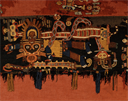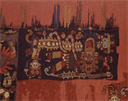Description
A monkey-like figure brandishes a small trophy head as it flies across this mantle. It is dressed with a tunic, loincloth, and leggings and wears anklets and bracelets, as well as an elaborate face mask. The mouth of the mask sprouts two colorful streamers that each end in a face with a long tongue. The monkey’s blue headdress consists of a central face with six extensions emerging out to the sides and curling up above, each also ending in a face. It is topped by gold rays, possibly representing a feather attachment. Other streamers emerge from the monkey’s arm and back, each in turn ending in a variety of heads, masked faces, tongues, and additional appendages.
This is a carefully planned, detailed depiction of a mythical being. A basting stitch, still in place alongside one of the figures, is evidence of the artist’s preliminary delimitation of the space the figure would occupy. The same image is repeated in a highly structured pattern over the central part of the rectangular mantle. It alternates between the upsidedown and right-side-up positions, appearing in seven different color combinations. The significance of these different iterations is lost to us today, but it is clear that they were carefully planned by the artist who created them.
To a member of Paracas society, this flying monkey with its accompanying paraphernalia was probably a recognizable character in local lore. It is one of several kinds of fantastic beings represented in the block-color embroideries that decorate textiles found in the necropolis on Peru’s Paracas Peninsula. Perhaps a deity, a mythic ancestor, a kind of totemic figure, or the animal-counterpart of a human transformed during a spiritual journey, it may have been intended to guard and protect the deceased owner of the mantle as he or she made the transition into the afterlife.
Bibliography
Bennett, Wendell C. 1937 The John Wise Collection of Ancient Peruvian Art, Wadsworth Athenaeum, Hartford, CT, cat. 268.
Benson, Elizabeth P. 1963 Handbook of the Robert Woods Bliss Collection of Pre-Columbian Art. Dumbarton Oaks, Trustees for Harvard University, Washington, D.C., p. 64, cat. 353.
Bliss, Robert Woods 1957 Pre-Columbian Art: The Robert Woods Bliss Collection. Text and Critical Analyses by S. K. Lothrop, Joy Mahler and William F. Foshag. Phaidon, New York. p. 278-279, cat. 344, pl. CXLI.
Bliss, Robert Woods 1959 Pre-Columbian Art: The Robert Woods Bliss Collection. 2nd ed. Text and Critical Analyses by S. K. Lothrop, Joy Mahler and William F. Foshag. Phaidon, London. p. 286-287, cat. 344, pl. CXLI.
Boone, Elizabeth Hill (ED.) 1996 Andean Art at Dumbarton Oaks. Pre-Columbian Art at Dumbarton Oaks; No. 1. Dumbarton Oaks Research Library and Collection, Washington, D.C. vol. 2, p. 353-357, pl. 98.
Bühl, Gudrun (ED.) 2008 Dumbarton Oaks: The Collections. Dumbarton Oaks Research Library and Collection, Washington, D.C., p. 278-9.
Callaway, Carol and Susan E. Bergh 1996 Form and Rhythm: Ancient Andean Textiles at Dumbarton Oaks. Hali. The International Magazine of Antique Carpet and Textile Arts (89):84-91. p. 84-91, fig. 6.
Christensen, Erwin O. 1955 Primitive Art. Bonanza Books, New York. p. 229.
Davies, Nigel 1997 The Ancient Kingdoms of Peru. Penguin Books, New York. fig. 13.
Fagan, Brian M. 2004 Ancient Lives: An Introduction to Archaeology and Prehistory. 2nd ed. Pearson/Prentice Hall, Upper Saddle River, NJ. p. 104, fig. 4.11.
Fagan, Brian M. 2006 Ancient Lives: An Introduction to Archaeology and Prehistory. 3rd ed. Pearson/Prentice Hall, Upper Saddle River, NJ. p. 101.
Fagan, Brian M. 2010 Ancient Lives: An Introduction to Archaeology and Prehistory. 4th ed. Pearson/Prentice Hall, Upper Saddle River, NJ. p. 99, 360, fig. 4.11.
Price, T. Douglas and Gary M. Feinman 1993 Images of the Past. Mayfield Publishing, Mountain View, CA. p. 365, pl. 16.
Price, T. Douglas and Gary M. Feinman 1997 Images of the Past. 2nd ed. Mayfield Publishing, Mountain View, CA. p. 353.
Price, T. Douglas and Gary M. Feinman 2001 Images of the Past. 3rd ed. Mayfield Publishing, Mountain View, CA. p. 375.
Price, T. Douglas and Gary M. Feinman 2005 Images of the Past. 4th ed. McGraw-Hill, Boston. p. 392.
Price, T. Douglas and Gary M. Feinman 2013 Images of the Past. 7th ed. McGraw-Hill, Boston. p. 386, fig. 7.16.
Stuart, George E. 2001 Ancient Pioneers: The First Americans. National Geographic Society, Washington, D.C., p. 164.
Exhibition History
"The John Wise Collection of Ancient Peruvian Art", Wadsworth Athenaeum, Hartford, CT, spring 1937 (catalogue # 268).
"Indigenous Art of the Americas", National Gallery of Art, Washington DC, April 1947 to June 1948 and April 1956 to July 1962.
Acquisition History
Purchased from John Wise, New York (dealer), by Robert Woods Bliss, 1947.
Robert Woods Bliss Collection of Pre-Columbian Art, Washington, DC, 1947-1962.
Dumbarton Oaks Research Library and Collection, Pre-Columbian Collection, Washington, DC.



